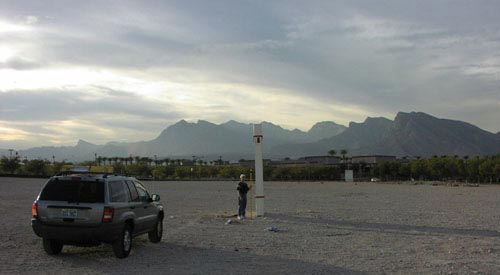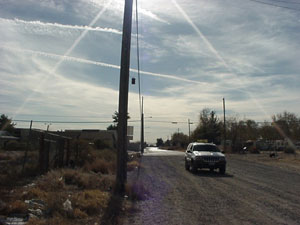
Las Vegas Valley Carbon Monoxide (CO) Saturation Study
The Clark County, Nevada, Department of Air Quality Management (DAQM) contracted a "saturation" study of carbon monoxide (CO) concentrations occurring during the seasonal period from before Thanksgiving to after New Year's Day, specifically, November 20, 2001 through January 5, 2002. Historically, this is the most likely period to have the highest CO concentrations measured by the County's air monitoring network. The study objectives are:
·
Obtain additional CO concentration information in
areas where the National
Ambient Air Quality Standard
(NAAQS) for CO has been exceeded (exceedances)
·
Improve the conceptual understanding of the relationship
between land use,
meteorology, and ambient
CO concentrations
· Identify geographic
areas with high CO concentrations
to support risk assessment and potential
population
exposure to CO exceedances, and
· Evaluate the current
Clark County DAQM monitoring
network CO sampling locations in accordance with
U.S. Environmental Protection Agency (EPA) siting criteria.
In short, the study was planned to answer two primary questions: are the DAQM monitoring sites adequately identifying the highest 8?hour average concentrations occurring in the metropolitan Las Vegas Valley area, and what geographic areas are affected by high CO concentrations? Prior to 1999, at least one 8?hour average per year exceeded the primary National Ambient Air Quality Standard (NAAQS) for CO, 9 parts-per-million (ppm). Aggressive efforts to reduce CO emissions have contributed to the significant decline in exceedance occurrences; none have been recorded since 1998. The saturation study was planned to provide the information to assess the adequacy of the spatial distribution of County DAQM monitoring sites.
Overview
of the Field Program
or link directly to the complete
Presentation
to the Air & Waste Management Association (AWMA)
The technical approach to meeting the study objectives was to operate a network of CO monitoring sites throughout the Valley, with emphasis on the locales historically most likely to experience the highest CO concentrations and where rapid recent development has occurred. Increasing the number of sampling locations well above the number of sites in the DAQM monitoring network effectively "saturates" the community with sampling locations to provide the data needed to achieve the study objectives. The Saturation Network was to be achieved by a combination of fixed (called "Static") sites and moveable (called "Dynamic") sites operated during the anticipated worst-case meteorological conditions. The samplers ran nearly continuously at the monitoring sites, producing a very complete record of CO concentrations at the selected locations. Another element in saturating the Valley with measurements was conducting mobile sampling using an instrument van during intensive operating periods (IOP). The van was driven around the Valley to observe CO loading in a real-time mode during nighttime and early-morning hours when meteorological conditions conducive to peak CO concentrations occur.
The network monitoring sites were located throughout the Las Vegas Valley, with a higher density east of the downtown area. Previous monitoring and modeling results indicated this to be the most likely area to encounter higher CO concentrations during periods of typical worst-case meteorological conditions and higher CO emission rates. The dynamic sites were located both to increase the density of sampling locations in the static network and to test other areas that might produce higher CO concentrations due to expected airflow pathways. As dynamic sites were installed and the preliminary data appeared useful in delineating spatial CO patterns, many were left operating continuously to maximize the amount of information collected.
The samplers used at the Saturation Network sites were small self-contained units manufactured by the Onset Computer Corporation. The sampler consists of an electrochemical sensor and on-board datalogger housed in a rectangular plastic container about four inches long by three inches wide and 1.5 inches high. The sampler was housed in a polyvinyl chloride (PVC) circular pipe section closed on the top with a grate on the bottom and holes in the side for air circulation. EPA recognizes the virtual impossibility of operating a network of reference analyzers in the density needed for a saturation study. Hence, various saturation studies have utilized non-reference sampling methods with appropriate comparisons to ensure adequacy of the information for the intended purposes. Preliminary tests in sampling chambers and the ambient environment coupled with comparative results from samplers collocated with DAQM designated equivalent analyzers at monitoring sites and in the mobile sampling van all showed excellent justification for recognizing results from the samplers as adequate for the purposes of this study.
Key Findings
Six of the Clark County DAQM CO monitoring sites are located in the parts of the Las Vegas Valley that experience the higher CO levels, and the Sunrise Acres site is centered in the area of maximum impact. This observation leads to the conclusion that the DAQM CO monitoring sites are suitably located to identify the peak CO concentrations and the corresponding general area in which the higher levels occur.
Aside from the S16 micro-scale site in downtown Las Vegas, the highest CO concentrations measured during the Saturation Study occurred in the vicinity of the Sunrise Acres DAQM site. This site has experienced the highest concentrations in the DAQM network during recent years. The Saturation Network revealed that relatively high CO levels extend beyond the major streets in the area into the residential neighborhoods. Figures showing the peak 8?hour average CO concentrations indicate that the higher concentrations (above 5 ppm) extend about one mile to the north, south, and east of the peak area. This area includes six of the DAQM CO monitoring sites: CC, CW, JD, FP, SA and MC. Most of the area covered by the higher CO concentrations is east of Interstate 15.
The peak 1-one-hour average CO concentration measured at the Saturation Study sites was 18.3 parts-per-million (ppm); this occurred at the S16 micro-scale exposure site near Casino Center and Fremont Street. The peak 1-hour averages at the remaining sites were all less than 10 ppm. These levels are all well below the 1-hour National Ambient Air Quality Standard (NAAQS) of 35 ppm.
The
peak 8-hour average CO concentration measured during the program was 7.2 ppm.
This occurred at the U16 site, which is two blocks south of the DAQM monitoring
site at the Sunrise Acres School near the intersection of Eastern Avenue, Charleston
Boulevard and Fremont Street. This CO level is below the 8?hour NAAQS of 9 ppm.
The peak 8?hour average occurring at the Sunrise Acres DAQM site (from November
20 through December 2001) was 6.0 ppm, which was during the same
8-hour time
period as the maximum at U16.
At least two secondary CO peak areas were observed in the Saturation Network that are not as well covered by the existing DAQM. One area is just northwest of the I15/95 interchange. The other is along the Boulder Highway where elevated concentrations of CO entrained in the nocturnal drainage were observed.
In the outlying areas of the Las Vegas Valley where DAQM monitoring is sparse, measured levels within the Saturation Network were confirmed to be very low.
Higher
than expected CO levels were observed in residential neighborhoods that are not
immediately adjacent to major thoroughfares. These elevated concentrations may
not be related to traffic patterns but instead, may be the result of other sources
of CO, such as space or water heating. The areas where this was observed are high
population density residential neighborhoods where CO exhaust from older heaters
and water-heating appliances may be significantly higher than in newer neighborhoods.

